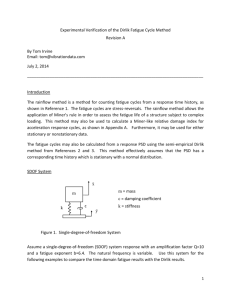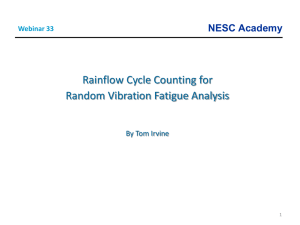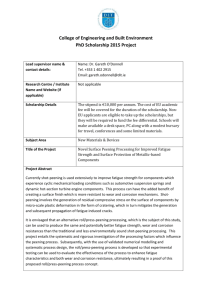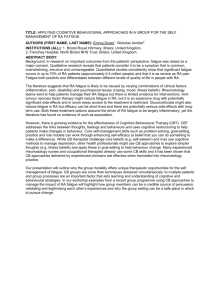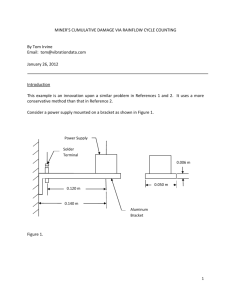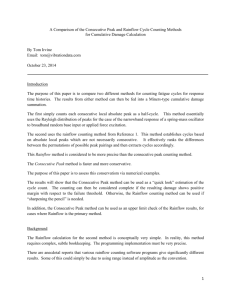estimate_fatigue_psd
advertisement
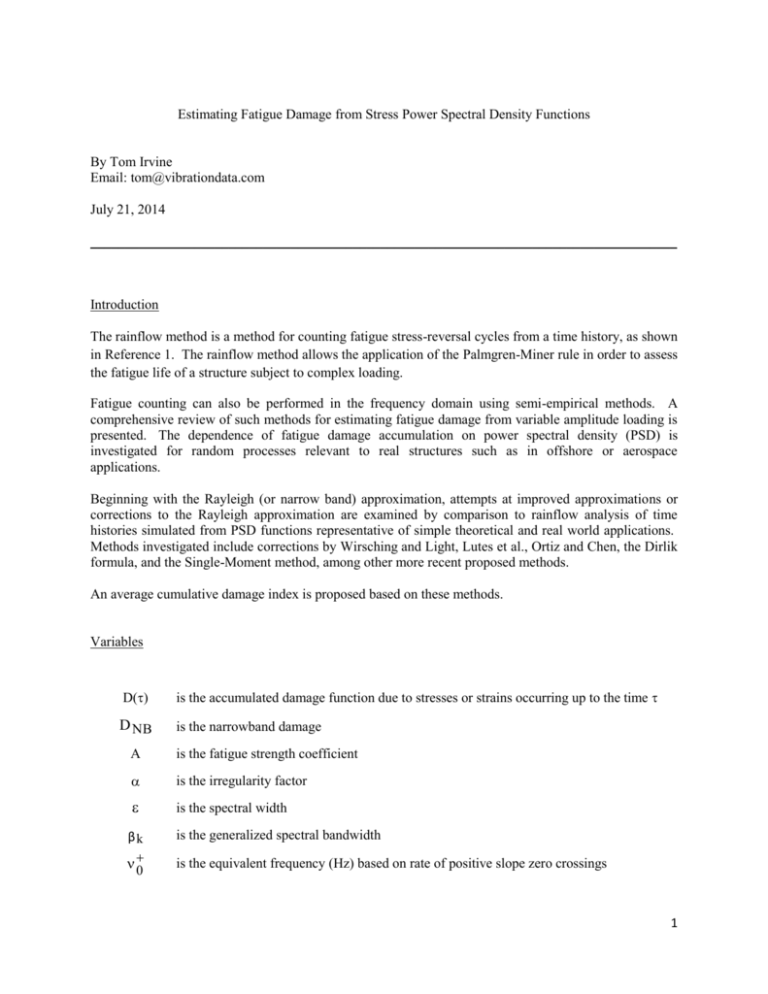
Estimating Fatigue Damage from Stress Power Spectral Density Functions By Tom Irvine Email: tom@vibrationdata.com July 21, 2014 _____________________________________________________________________________________ Introduction The rainflow method is a method for counting fatigue stress-reversal cycles from a time history, as shown in Reference 1. The rainflow method allows the application of the Palmgren-Miner rule in order to assess the fatigue life of a structure subject to complex loading. Fatigue counting can also be performed in the frequency domain using semi-empirical methods. A comprehensive review of such methods for estimating fatigue damage from variable amplitude loading is presented. The dependence of fatigue damage accumulation on power spectral density (PSD) is investigated for random processes relevant to real structures such as in offshore or aerospace applications. Beginning with the Rayleigh (or narrow band) approximation, attempts at improved approximations or corrections to the Rayleigh approximation are examined by comparison to rainflow analysis of time histories simulated from PSD functions representative of simple theoretical and real world applications. Methods investigated include corrections by Wirsching and Light, Lutes et al., Ortiz and Chen, the Dirlik formula, and the Single-Moment method, among other more recent proposed methods. An average cumulative damage index is proposed based on these methods. Variables D() is the accumulated damage function due to stresses or strains occurring up to the time D NB is the narrowband damage A is the fatigue strength coefficient is the irregularity factor is the spectral width βk 0 is the generalized spectral bandwidth is the equivalent frequency (Hz) based on rate of positive slope zero crossings 1 p is the rate of peaks m is the fatigue strength exponent from the material S-N curve F is the frequency (Hz) Ws is the one-sided, wideband stress power spectral density (stress^2/Hz) Mj is the j th moment of the one-sided spectral density S is the stress cycle range (peak-to-valley) N(S) is the histogram function for stress cycles is the exposure time (sec) S is the response stress overall RMS level is the narrowband correction factor is the gamma function The fatigue strength coefficient A for the purpose of this paper is taken as the stress level on the S-N curve where N=1/2 cycles, assuming no reduction in slope due to strain hardening in the low-cycle range. An alternate method is to calculate the A value using fracture mechanics for the case of a preexisting crack. Note that 0 M j f j Ws (f ) df (1) The index j may be a non-integer. The rate of zero up-crossings can be estimated as 0 M2 M0 (2) M4 M2 (3) The rate of peaks is p The irregularity factor is i Mi M 0 M 2i (4) 2 A special case is 2 M2 M0 M4 0 (5) p The spectral width is 1 22 (6) Narrowband Stress The narrowband damage D NB from Reference 2 is D NB 0 A 1 2 S m m 1 2 Note that failure is assumed to occur when D > 1.0. conservatively lower. (7) But some references use thresholds which are Wideband Stress Methods Correction Factor The wideband damage can be estimated from the narrowband damage as D D NB (8) The value is a generic scale factor. Specific types are given Wirsching and Lite Wirsching and Lite developed the following correction factor by simulating processes having a variety of spectral shapes, in Reference 2. W , m a (m) 1 a (m)1 b(m) (9) a(m) = 0.0926 - 0.033 m (10) b(m) = 1.587 m – 2.323 (11) 3 Note that Wirsching and Lite used the S-N slope m values of 3, 4, 5 and 6 for the simulations. Larsen and Lutes Larsen and Lutes have given the following empirical correction factor, referred to in the literature as the Single-Moment method, in References 3 and 4. L M 2 / m m / 2 (12) Sm 0 Note that the M 2 / m m / 2 term is evaluated using j = 2/m in equation (1) The direct Larsen and Lutes cumulative damage is D A 2 m M 2 / m m / 2 12 m 1 (13) Equation (13) shows the single-moment dependency. Oritz and Chen Ortiz and Chen developed the following correction factor by applying the generalized spectral bandwidth to the Rayleigh distribution, from Reference 2. m k k (14) 2 The generalized spectral bandwidth is k M 2M k M0M k 2 , k = 2.0/m (15) 4 Benasciutti & Tovo The first Benasciutti & Tovo correction factor from Reference 5 is m 1 BT b (1 b) 2 2 (16) where b 1 2 1.112 1 1 2 (1 2 )exp 2.11 2 1 2 2 (17) α 0.75 Method The 0.75 correction factor from Reference 5 proposed by Benasciutti & Tovo is 2 0.75 (18) Dirlik The Dirlik method is shown in Appendix A, from Reference 5. It approximates the cycle-amplitude distribution by using a combination of one exponential and two Rayleigh probability densities. Zhao-Baker Zhao and Baker combined theoretical assumptions and simulation results to give an expression for the cycle distribution as a linear combination of the Weibull and Rayleigh probability density function. There method is shown in Appendix B, from Reference 5. Rainflow Cycle Count in the Time Domain A time history with a normal distribution can be synthesized to match an applied force or base excitation power spectral density. The excitation can then be applied to a structural model. The structure’s response can then be calculated via a modal transient analysis. The resulting stress can then be calculated as a post-processing step from the strain response. The rainflow cycles can then be calculated using the method in Reference 1. The cumulative damage is then calculated via the Palmgren-Miner formula, per Reference 6. 5 Palmgren-Miner Index Palmgren-Miner’s cumulative damage index D is given by D i 1 ni Ni (19) where ni is the number of stress cycles accumulated during the vibration testing at a given level stress level represented by index i Ni is the number of cycles to produce a fatigue failure at the stress level limit for the corresponding index The damage index D for a single-segment S/N curve can be expressed as D 1 A Si m (20) i 1 Analysis Approach The input and stress response levels for a sample dynamic system are given in Appendix C. The resulting fatigue cycles were calculated using the time domain simulation with rainflow cycle counting, as well as the frequency domain methods previously given. The time domain results are considered as the reference by which the frequency domain methods are evaluated, although the time domain results remain a simulation. Assumptions 1. 2. 3. 4. 5. Single-segment S-N curve Neglect endurance limit All stresses below yield Fatigue cycles are fully reversed with zero mean stress Stationary stress time histories Materials Three material cases were considered as shown in Table 1. These materials have nearly the same specific stiffness values such that a common stress PSD can be applied for the three materials. 6 Table 1. Material Properties, For Reference Only Material M A Reference Butt-Welded Steel 3.5 1.26e+11 ksi^3.5 2 Stainless Steel1 6.54 1.32E+18 ksi^6.54 7 Aluminum 6061-T6 9.25 9.77e+17 ksi^9.5 6 Note that offshore steel structures with welded joints typically have a fatigue exponent of m 3 per Reference 8. Example 1 A single-mode stress response PSD is shown in Figure C-3. The fatigue analysis results are shown in Table 2. Table 2. Cumulative Damage Results D, Single-mode Stress Response PSD Method Butt-Welded Steel Material Stainless Steel Rainflow Cycle Count 0.00373 0.00559 0.00119 Narrowband 0.00394 0.00620 0.00139 Wirsching Light 0.00339 0.00447 0.000867 0.75 0.00382 0.00602 0.00135 Ortiz Chen 0.00402 0.00631 0.00141 Lutes Larsen 0.00379 0.00591 0.00132 Benasciutti Tovo 0.00369 0.00546 0.00118 Zhao Baker 0.00372 0.00591 0.00139 Dirlik 0.00377 0.00565 0.00113 Average 0.00380 0.00588 0.00130 Aluminum The average is obtained by using the six methods in Table 2 starting with 0.75 and ending with Dirlik. 1 Martensitic precipitation/age-hardening stainless steel, unnotched PH13-8Mo (H1000) hand forging 7 Example 2 A bimodal stress response PSD is shown in Figure C-4. The resulting fatigue cycles are shown in Table 3. Table 3. Cumulative Damage Results D, Bimodal Stress Response PSD Method Butt-Welded Steel Material Stainless Steel Rainflow Cycle Count 0.0212 0.0818 0.0400 Narrowband 0.0244 0.0961 0.0488 Wirsching Light 0.0203 0.0684 0.0303 0.75 0.0209 0.0825 0.0419 Ortiz Chen 0.0213 0.0814 0.0409 Lutes Larsen 0.0203 0.0767 0.0384 Benasciutti Tovo 0.0197 0.0672 0.0320 Zhao Baker 0.0215 0.0831 0.0420 Dirlik 0.0199 0.0717 0.0324 Average 0.0206 0.0771 0.0379 Aluminum Again, the average is obtained by using the six methods in Table 3 starting with 0.75 and ending with Dirlik. 8 Summary The damage results from the two examples are given in Table 4. Table 4. Error Ratios for Frequency Domain Relative to Time Domain Damage 0.024 Ortiz Chen 0.078 Lutes Larsen 0.016 Benasciutti Tovo 0.011 Zhao Baker 0.003 2 0.077 0.129 0.057 0.023 3 0.134 0.185 0.109 4 0.014 0.005 5 0.009 6 Case 0.75 1 Dirlik Average 0.011 0.019 0.057 0.011 0.052 0.008 0.168 0.050 0.092 0.042 0.071 0.014 0.061 0.028 0.005 0.062 0.178 0.016 0.123 0.057 0.048 0.023 0.040 0.200 0.050 0.190 0.052 Mean 0.051 0.071 0.055 0.082 0.051 0.074 0.050 Max 0.134 0.185 0.109 0.200 0.168 0.190 0.092 The error values are absolute values. The six cases represent stress PSD and material combinations. Cases 1 through 3 are taken from Table 2, for butt-welded steel, stainless steel, and aluminum, respectively. Cases 4 through 6 are likewise taken from Table 3. The average in the last column is not the average error for a given case. Rather it is the error of the average frequency domain damage relative to the time domain rainflow cycle damage. The results show that the 0.75 and Zhao-Baker methods tie for giving the smallest mean damage error. The Lutes-Larsen method gives the least maximum error and may thus be the best single method. The average of the six methods gives smaller mean and maximum errors than any of the individual methods. 9 Conclusions The several frequency domain methods tend to provide reasonably good estimates of the cumulative fatigue damage with some limitations. The Narrowband method should only be used with an applied correction factor. In addition, the Wirsching-Light method should only be used for cases with fatigue exponents in the range of 3 to 6, inclusive. An average cumulative damage index based on the six methods in Table 4 is recommended for calculating an estimate with enhanced reliability. Note that the computation time for implementing this averaging method is negligibly low. An effort was made to derive a weighted average method, but the simple average was determined to be the best metric for the six cases. The quest for greater precision in the damage calculation is justified but somewhat academic. Uncertainties in S-N curves, stress concentration factors, mean stress, load sequence, thermal and corrosion environments, natural frequencies, damping and other variables must also be considered. References 1. ASTM E 1049-85 (2005) Rainflow Counting Method, 1987. 2. P. Wirsching, T. Paez, K. Ortiz, Random Vibrations Theory and Practice, Dover, New York, 2006. 3. C. Larsen & L. Lutes, Predicting the Fatigue Life of Offshore Structures by the Single-Moment Spectral Method, Probabilistic Engineering Mechanics, 6(2), 1991. 4. L. Lutes & C. Larsen, Improved Spectral Method for Variable Amplitude Fatigue Prediction, ASCE Journal of Structural Engineering, 116(4), 1990. 5. M. Mrsnik, J. Slavic and M. Boltezar, Frequency-domain Methods for a Vibration-fatigue-life Estimation -Application to Real Data. International Journal of Fatigue, Vol. 47, p. 8-17, 2013. 6. T. Irvine, Miner’s Cumulative Damage via Rainflow Cycle Counting, Rev G, Vibrationdata, 2014. 7. MIL-HDBK-5J, Metallic Materials and Elements for Aerospace Vehicle Structures, U.S. Department of Defense, 2003. 8. Commentary on the Guide for the Fatigue Assessment of Offshore Structures, American Bureau of Shipping, New York, April 2003. 9. T. Irvine, The Longitudinal Vibration Response of a Rod to an Applied Force, Rev D, Vibrationdata, 2014. 10 APPENDIX A Dirlik Method The Dirlik histogram formula N(S) for stress cycles ranges is N(S) p p (S) (A-1) The function p(S) is p (S) 2 Z2 D1 Z D Z D Z exp Z exp 2 exp 3 2R 2 2 Q Q R2 2 m0 (A-2) The coefficients and variables are 2 xm 2 1 2 D1 D2 1 D1 D12 1 R D3 1 D1 D 2 Z Q S 2 m0 1.25 D 3 D 2 R D1 x m D12 R 1 D1 D12 (A-3) (A-4) (A-5) (A-6) (A-7) (A-8) 11 xm m2 m0 m4 m1 m0 m2 m4 (A-9) (A-10) The Dirlik cumulative damage is 1 Sm N(S) dS D 2 m A 0 (A-11) 12 APPENDIX B Zhao & Baker Method The probability density function p ( Z) for stress cycles amplitude is p ( Z) w Z 1 exp Z 1 w Z exp Z 2 / 2 (B-1) where Z S / S (B-2) The weighting factor w is w 1 2 2 1 1 / 1 1 (B-3) The Weibull parameters are 8 7 2 (B-4) 1.1 for 2 0.9 1.1 9 2 0.9 for 2 0.9 (B-5) The Zhao & Baker cumulative damage is p m m S D 0 Z p (Z) dZ , dZ dS / S A (B-6) 13 APPENDIX C Rod, Applied Force and Response E , A, F(t) L Figure C-1. Consider a thin, fixed-free rod subjected to an applied force at the free end. Table C-1. Sample Rod Properties, Aluminum Length L = 84 inch Diameter D = 1 inch Area A = 0.785 inch^2 Area Moment of Inertia I = 0.0491 inch^4 Elastic Modulus E = 1.0e+07 lbf/in^2 Mass Density = 0.1 lbm/in^3 Speed of Sound in Material c = 1.96e+05 in/sec Viscous Damping Ratio = 0.05 for mode 1 0.02 for mode 2 14 FORCE POWER SPECTRAL DENSITY OVERALL LEVEL = 1580 lbf RMS 2 FORCE (lbf /Hz) 10000 1000 100 10 100 1000 2500 FREQUENCY (Hz) Figure C-2. Force PSD, 1580 lbf RMS, 600 seconds Frequency (Hz) Force (lbf2/Hz) 10 1000 2500 1000 The level in Table C-1 was increase by a factor of 12 dB for the case of stainless steel in order to induce a non-trivial cumulative damage index. The one and two-mode stress responses for the nominal force input are shown in Figures C-2 and C-3, respectively. The stress level are calculated the rod’s fixed boundary per Reference 9. 15 STRESS POWER SPECTRAL DENSITY 4.91 ksi RMS Overall 1 2 STRESS (ksi /Hz) 0.1 0.01 0.001 0.0001 10 100 1000 2500 FREQUENCY (Hz) Figure C-3. 16 STRESS POWER SPECTRAL DENSITY 6.64 ksi RMS Overall 1 2 STRESS (ksi /Hz) 0.1 0.01 0.001 0.0001 10 100 1000 2500 FREQUENCY (Hz) Figure C-4. 17
